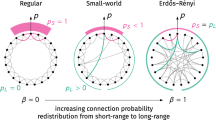Abstract
Bluetooth scatternets may be operated in a loosely coupled mode, called Walk-In Bridge Scheduling, in which the master polls all of its slaves and bridges using E-limited service. Using the theory of queues with vacations, we derive the stability criteria for packet queues in piconet masters, slaves, and bridges. We show that the stability of the slave queues is more critical under high traffic locality, whereas the stability of the bridge queues becomes progressively more important as the non-local traffic increases. Our analysis shows that the limited exchange mode, in which the bridge residence time in a piconet is limited, performs better and has a wider stability region than the complete exchange mode in which the bridge stays in the piconet until all queued packets are exchanged. Simulations show that this scheduling approach offers good performance and excellent scalability, while maintaining scatternet stability.
Similar content being viewed by others
References
Artis Software Inc., Artifex v.4.2.1. (San Jose, CA, 2001).
S. Baatz, M. Frank, C. Kühl, P. Martini and S. Christoph, Bluetooth scatternets: An enhanced adaptive scheduling scheme, in: Proceedings Twenty-First Annual Joint Conference of the IEEE Computer and Communications Societies IEEE INFOCOM 2002, New York (June 2002) pp. 782–790.
S. Baatz, M. Frank, C. Kühl, P. Martini and C. Scholz, Adaptive scatternet support for Bluetooth using Sniff mode, in: Proceedings of the 26th Annual Conference on Local Computer Networks LCN 2001, Tampa, FL (Nov. 2001).
J. Bak and D.J. Newman, Complex Analysis (Springer-Verlag, New York, NY, 1982).
D.M. Bakker and D. McMichael Gilster, Bluetooth End-To-End (Hungry Minds, Inc., New York, NY, 2002).
Bluetooth SIG, Bluetooth network encapsulation protocol (BNEP) specification. Technical report, Revision 0.95a (June 2001).
Bluetooth SIG, Specification of the Bluetooth System, Version 1.1 (Feb. 2001).
A. Capone, R. Kapoor and M. Gerla, Efficient polling schemes for Bluetooth picocells, in: Proceedings of IEEE International Conference on Communications ICC 2001, vol. 7, Helsinki, Finland (June 2001) pp. 1990–1994.
N. Johansson, F. Alriksson and U. Jönsson, JUMP mode—a dynamic window-based scheduling framework for Bluetooth scatternets, in: Proceedings 2001 ACM International Symposium on Mobile ad hoc Networking & Computing, Long Beach, CA (Oct. 2001) pp. 204–211.
N. Johansson, U. Körner and P. Johansson, Performance evaluation of scheduling algorithms for Bluetooth, in: D.H.K. Tsang and P.J. Kuhn Proceedings of BC’99 IFIP TC 6 Fifth International Conference on Broadband Communications, (eds.) Hong Kong (Nov. 1999) pp. 139–150.
N. Johansson, U. Körner and L. Tassiulas, A distributed scheduling algorithm for a Bluetooth scatternet, in: Proceedings of the International Teletraffic Congress–ITC-17, Salvador de Bahia, Brazil (Sept. 2001) pp. 61–72.
P. Johansson, R. Kapoor, M. Kazantzidis and M. Gerla. Rendezvous scheduling in Bluetooth scatternets, in: Proceedings of IEEE International Conference on Communications ICC 2002, New York (Apr. 2002) pp. 318–324.
M. Kalia, D. Bansal and R. Shorey, Data scheduling and SAR for Bluetooth MAC, in: Proceedings VTC2000-Spring IEEE 51st Vehicular Technology Conference, vol. 2, Tokyo, Japan (May 2000) pp. 716–720.
D. Miorandi, C. Caimi and A. Zanella, Performance characterization of a Bluetooth piconet with multi-slot packets, in: Proceedings WiOpt’03, Sophia-Antipolis, France (Mar. 2003).
J. Mišić, K.L. Chan and V.B. Mišić, Performance of Bluetooth piconets under E-limited scheduling. Tech. report TR 03/03, Department of Computer Science, University of Manitoba, Winnipeg, Manitoba, Canada, (May 2003).
J. Mišić and V.B. Mišić, Modeling Bluetooth piconet performance. IEEE Communication Letters 7(1) (2002) 18–20.
J. Mišić and V.B. Mišić, Bridges of Bluetooth county: topologies, scheduling, and performance. IEEE Journal on Special Areas in Communications—Wireless Series 21(2) (2003) 240–258.
A. Rácz, G. Miklós, F. Kubinszky and A. Valkó, A pseudo random coordinated scheduling algorithm for Bluetooth scatternets, in: Proceedings 2001 ACM International Symposium on Mobile ad hoc Networking & Computing, Long Beach, CA, (Oct. 2001) pp. 193–203.
H. Takagi, Queueing Analysis, vol. 1: Vacation and Priority Systems. (North-Holland, Amsterdam, The Netherlands, 1991).
G. Tan and J. Guttag, A locally coordinated scatternet scheduling algorithm, in: Proceedings of the 26th Annual Conference on Local Computer Networks LCN 2002, Tampa, FL (Nov. 2002) pp. 293–303.
E.T. Whittaker and G.N. Watson, A Course of Modern Analysis (Cambridge University Press, Cambridge, UK, 1952).
W. Zhang and G. Cao, A flexible scatternet-wide scheduling algorithm for Bluetooth networks, in: Proc. 21st IEEE International Performance, Computing, and Communications Conference IPCCC 2002, Phoenix, AZ (Apr. 2002).
Author information
Authors and Affiliations
Corresponding author
Additional information
Vojislav B. Mišić received his PhD in Computer Science from the University of Belgrade, Yugoslavia, in 1993. He is currently Assistant Professor of Computer Science, at the University of Manitoba in Winnipeg, Manitoba, Canada. Previously, he has held posts at the University of Belgrade, Yugoslavia, and the Hong Kong University of Science and Technology. His research interests include systems and software engineering and modeling and performance evaluation of wireless networks. He is a member of ACM, AIS, and IEEE.
Jelena Mišić received her PhD degree in Computer Engineering from the University of Belgrade, Yugoslavia, in 1993. She is currently Associate Professor of Computer Science at the University of Manitoba in Winnipeg, Manitoba, Canada. Previously, she has been with the Hong Kong University of Science and Technology. Her current research interests include wireless networks and mobile computing. She is a member of IEEE Computer Society.
Ka Lok Chan received his MPhil degree in performance of Bluetooth networks at the Hong Kong University of Science and Technology.
Rights and permissions
About this article
Cite this article
Mišić, V.B., Mišić, J. & Chan, K.L. Walk-In Bridge Scheduling in Bluetooth Scatternets. Cluster Comput 8, 197–210 (2005). https://doi.org/10.1007/s10586-005-6185-5
Issue Date:
DOI: https://doi.org/10.1007/s10586-005-6185-5




